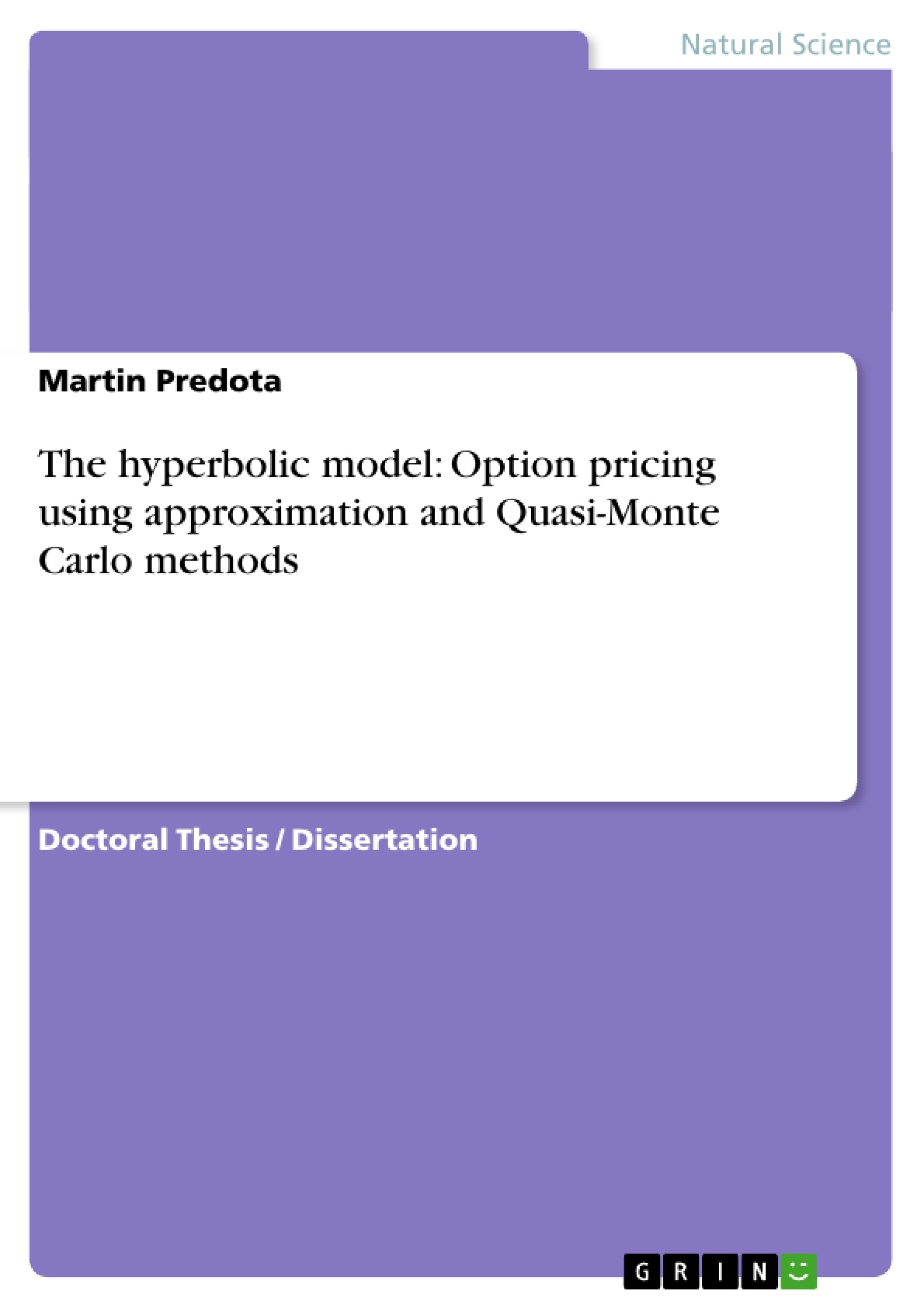Excerpt
Martin Predota
The hyperbolic model:
Option pricing using approximation
and Quasi-Monte Carlo methods
Dissertation
Ausgeführt zum Zwecke der Erlangung
des akademischen Grades eines
Doktors der technischen Wissenschaften
eingereicht an der
Technischen Universität Graz
Technisch-Naturwissenschaftliche Fakultät
____
Supported by the Austrian Science Foundation (FWF) FSP-Project S 8308-MAT
Für Oma
Es heißt nicht sterben, lebt man in den Herzen der Menschen fort.
Samuel Smiles
Preface
Since Black and Scholes have presented their seminal article on option pricing in 1973, there has been a lot of scientific activity in this research area. In 1995, Eberlein and Keller proposed a more realistic approach, the hyperbolic model. In this thesis we generalize their results to other than standard European options.
The content of the chapters is as follows. In Chapter 1 we give basic properties of L´evy processes and infinitely divisible distributions. We introduce the generalized hyperbolic distribution, and the corresponding L´evy motions, which will be needed for modelling stock prices. Chapter 2 gives a brief introduction to the field of option pricing as well as to Monte Carlo and Quasi-Monte Carlo methods. We also compare European option prices in the hyperbolic model and in the Black-Scholes model. In Chapter 3 we simulate Asian Esscher option prices based on the general mean using Monte Carlo methods with variance reduction techniques and Quasi-Monte Carlo methods. In Chapter 4 the normal inverse Gaussian (NIG) model in the context of Asian options is investigated. We give approximation and simulation results and use stop-loss transforms to obtain uppers bound for these Esscher option prices. Chapter 5 contains algorithms used for the simulation of American options prices. In Chapter 6 we discuss an alternative to the Esscher martingale measure, namely the minimal entropy martingale measure, to obtain option prices in the NIG model. And finally Chapter 7 gives a short survey on multi-asset options in the NIG model.
I take this opportunity to thank my thesis advisor O.Univ.-Prof. Dr. Robert F. Tichy for his encouragement, confidence and support. I would also like to thank Univ.-Prof. Dr. Gerhard Larcher for his promotion and support. Furthermore, I would like to thank all those, who contributed in various ways to the development of this thesis, especially Hansjörg Albrecher, Jürgen Hartinger, Gunther Leobacher and Elmar Teufl. Last but not least I would like to thank my parents for their support and credit.
Graz, February 1st, 2002
M.P.
Contents
1 Hyperbolic L´evy processes 1
1.1 Introduction 1
1.2 L´evy processes 1
1.3 Infinitely divisible distributions 5
1.4 The generalized hyperbolic distribution 10
1.4.1 The hyperbolic distribution 13
1.4.2 Asymptotic ML-estimators 14
1.4.3 Approximating the inverse distribution function 19
1.4.4 The NIG distribution 21
1.5 The loghyperbolic distribution 22
1.6 The hyperbolic L´evy motion 24
1.6.1 NIG processes 29
1.6.2 Changing measures 29
2 Option pricing and Quasi-Monte Carlo methods 31
2.1 Introduction 31
2.2 Basic concepts of option pricing 31
2.2.1 The Black-Scholes model 33
I
2.2.2 The generalized hyperbolic model 35
2.3 Monte Carlo methods and variance reduction 44
2.3.1 Variance reduction techniques 47
2.4 Quasi-Monte Carlo methods 48
3 Asian options 55
3.1 Introduction 55
3.2 Options on the general mean 56
3.3 Approximation of arithmetic average options 68
4 Asian option pricing in the NIG model 73
4.1 Introduction 73
4.2 Stop-loss transforms and upper bounds for arithmetic average options 73
4.3 Approximations for arithmetic average options 79
4.4 Arithmetic and geometric average options 82
4.5 Comparison with the Black-Scholes-model 85
5 American options 89
5.1 Introduction 89
5.2 American option pricing 89
5.3 Bundling algorithm 91
5.4 Simulated Tree Algorithm 94
6 The minimal entropy martingale measure 101
6.1 Introduction 101
6.2 L´evy processes and the minimal entropy martingale measure 102
6.3 The minimal entropy martingale measure for NIG L´evy processes 105
II
6.4 Option pricing 107
7 Options on several assets 111
7.1 Introduction 111
7.2 The d-dimensional hyperbolic distribution 111
7.3 Option pricing 114
Bibliography 117
III
Chapter 1
Hyperbolic L´evy processes
1.1Introduction
L´evy processes were first characterized by Paul L´evy in the 1930s. These processes are an excellent tool for modelling price processes in mathematical finance. Compared with semimartingales they have a simple structure. Thus, they can be used for practical applications. An overview on using L´evy processes in finance is given by BarndorffNielsen and Shepard [BS00].
In this chapter we give basic definitions and results concerning L´evy processes and
the related infinitely divisible distributions, in particular the generalized hyperbolic distribution. This distribution plays an important role in the context of modelling financial derivatives (see e.g. Eberlein [Eb98]).
This chapter contains parts of the articles The loghyperbolic distribution: Basic properties and random number generation [Pr01] by Predota and ML-estimators for parameters of hyperbolic densities in finance [PT01] by Predota and Tichy. [...]
- Quote paper
- Dr. Martin Predota (Author), 2002, The hyperbolic model: Option pricing using approximation and Quasi-Monte Carlo methods, Munich, GRIN Verlag, https://www.grin.com/document/125316
Publish now - it's free






















Comments